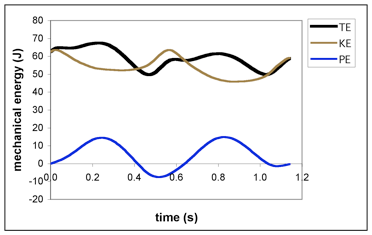

This paper originates from a proposal from Prof. Franco Saibene to write together a review article on legged locomotion.Current (2003) knowledge about many different aspects of walking and running in humans, including part of our own published research, are illustrated
Following the Introduction, these are the main chapters: MECHANICAL PARADIGMS, MODELS, HOW TO MEASURE MECHANICAL WORK, STNDARDIZATION, TRANSITION BETWEEN GAITS, GRADIENT LOCOMOTION, EFFECTS OF SIZE, EFFECTS OF g, ENHANCED LEG LOCOMOTION, EFFECTS OF THE RUNNING SURFACE, PERSPECTIVES AND CONCLUSION.
Particularly, to write that review article was the opportunity to include an APPENDIX where the complete set of equations necessary to calculate the mechanical external work of locomotion from 3D ground reaction forces was presented. In addition, an Excel spreadsheet with the calculation done (a partial output is shown in the graph at the right hand side) was made available. Unfortunately, the indicated link (www.mmu.ac.uk/c-a/exspsci/research/biomex/biomres1.htm) no longer exists. Today that file can be downloaded HERE.

Tuesday, April 8, 2003
REVIEW ARTICLE: Biomechanical and physiological aspects of legged locomotion in humans
Figure 9 of the Review article
Walking speed as a function of body size, here represented by the leg length relative to adult length. The Froude dimensionless speed, already used to standardize the effects of gravity on locomotion, allows here to predict dinamically equivalent waling speeds for subjects of very different size.
Click on the REF above to require a pdf file




